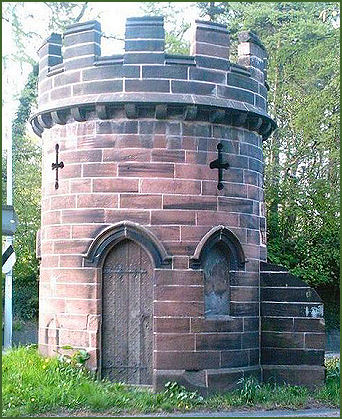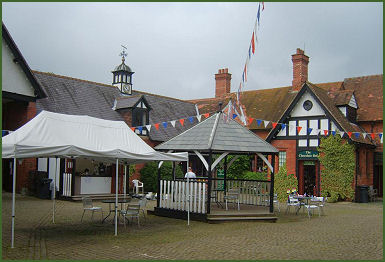Sandiway
OS Grid ref:-
 The Cheshire village of Sandiway is situated around 3 miles from Delamere Forest and around six miles to the west of the town of Northwich. The name derives from when the village was little more more than a 'sandy way' on the Roman Watling Street.
The Cheshire village of Sandiway is situated around 3 miles from Delamere Forest and around six miles to the west of the town of Northwich. The name derives from when the village was little more more than a 'sandy way' on the Roman Watling Street.
One of the village's most famous sons was the celebrated architect John Douglas (1830-1911) who is regarded as one of the outstanding architects of his generation. Douglas designed many buildings in Chester and a number of Cheshire churches. He also designed the village church of St John's. He donated the land on which the church the church was built and paid for the chancel and the lych gate.
The red sandstone Round Tower Lodge, (pictured left) a famous landmark in the village, is now situated in the central reservation of the A556 road, the tower lodge is all that remains of a gate lodge to the house of Vale Royal Abbey. The lodge was constructed in the early nineteenth century as an entrance to Vale Royal's New Park and at one tme was linked to the house by a driveway. After World War the New Park became Sandiway Golf Course. Vale Royal Abbey was founded by King Edward I in 1277. Much of the surrounding land, including what is now Sandiway, was held and ruled by the Abbott. The old abbey was destroyed during the Dissolution of the Monasteries under King Henry VIII and a mansion later built on the site by Sir Thomas Holcroft, the mansion is now divided into apartments and serves as a club-house for Vale Royal Golf Club.
The Blue Cap Inn dates back to the 1712 and was built on the old Chester to London coaching route, the inn is named after a famous local hunting hound and offers excellent food.
Oakmere Hall, which is situated to the southwest of the village, set in 13 acres of parkland, is built in the French Gothic syle and dates to 1867, it was one of the earlier works of John Douglas. It was built for John & Thomas Johnson, merchants and chemical manufacturers of Runcorn.
 The Blakemere Craft Centre, (pictured right) which is set in an attractive Edwardian stable block and cobbled courtyard, consists of numerous craft shops offering gifts, with a further 4,000 square feet Antiques & Collectables Emporium. The centre also has an outdoor children's play area and indoor playbarn. Various events at are scheduled throughout the year and the entertainment programme is free of charge.
The Blakemere Craft Centre, (pictured right) which is set in an attractive Edwardian stable block and cobbled courtyard, consists of numerous craft shops offering gifts, with a further 4,000 square feet Antiques & Collectables Emporium. The centre also has an outdoor children's play area and indoor playbarn. Various events at are scheduled throughout the year and the entertainment programme is free of charge.
Nearby places of interest
Delamere Forest, owned by the Forestry Commision, the forest is all that remains of the great Norman hunting forest of Mara and Mondrum, which once covered much of Cheshire. Once one of the hunting forests of the Norman Earls of Chester, it may have previously been an Anglo-Saxon hunting forest. In the early middle ages the forest covered over 60 square miles (160 km2), stretching from the Mersey in the north to a few miles north of Nantwich in the south, and from the Gowy in the west to the Weaver in the east.
Anderton Nature Park lies adjacent to the historic Anderton Boat lift, close to Northwich town centre. The site, once an industrial wasteland, is a haven for wildlife and in particular a favourite haunt for both keen and amateur botanists where a Wild Flower Trail can be discovered by those wanting to explore.
Marbury Country Park once part of a large country estate, the history of the estate stretches back to the thirteenth century. The mere, which is used for watersports, has some excellent views over to Great Budworth church. In the spring the woodland by the mere is awash with a carpet of bluebells and other wildflowers. The woodland contains some impressive and interesting wooden sculptures which have been carved from dead trees.
Arley Hall and Gardens winner of 'Small Visitor Attraction of the Year' at the 2006 Northwest Tourism Awards, is situated near the village of Great Budworth. The Arley estate has been held by the Warburton family since the end of the twelfth century. In 1469 Piers Warburton moved his principal seat from Warburton to Arley, and built the first house to occupy the site.
